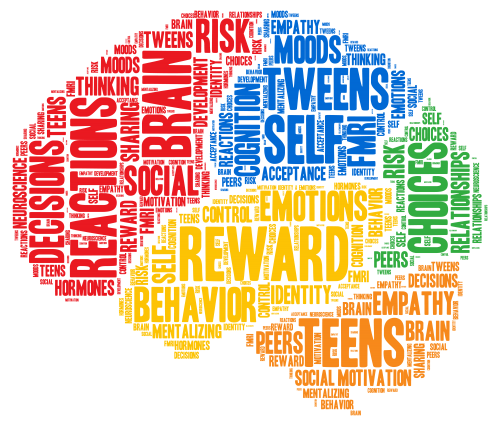Research
 What is Developmental Social Neuroscience?
What is Developmental Social Neuroscience?
Ideas about the self, perceptions and understanding of others, emotions, motivations, decision-making, and self-regulatory abilities dramatically differ between a child at age 7, a “tween” at age 11, and an adolescent at age 15. Developmental psychologists have spent decades demonstrating how cognitive and social contextual factors contribute to these changes. But what role does the brain play in this important transitional period? The overarching goal of developmental social neuroscience is to understand the neural systems that support socioemotional development from childhood to adulthood, by drawing on theories and methods from developmental and social psychology as well as cognitive neuroscience. We aim to apply this knowledge about the science of adolescent development to improve outcomes, particularly for those youth who are most at risk.
Developmental Social Neuroscience at UO
The transition from childhood through adolescence is characterized by changing brains and bodies, affect and motivation, peer relationships and conceptions of self – many strands which combine to shape behavior during this critical period. Most models of brain development emphasize the imbalanced contributions of reactive and regulatory systems to adolescent behavior (Casey et al., 2008; Ernst, 2009; Steinberg, 2008, 2010). The driving force behind our research at the University of Oregon, however, is to integrate the contributions of social cognitive systems into these neurobiological theories of adolescent affect, motivation, and decision-making, specifically as revealed by the study of self-development, mentalizing, and peer relations.
In practice, our laboratory works towards this goal in three complementary ways. One line of research tracks social brain development across adolescence, to build a foundational body of knowledge comparable to developmental neuroimaging investigations of reactive and regulatory systems. These studies have focused primarily on self-development and mentalizing as model phenomena. Another line of research aims to empirically test the assumptions the field has been making about human adolescent neurodevelopment in these dominant models. These studies have focused on topics such as affective and motivational reactivity, self-regulation, pubertal development, and their interrelationships. The third and most recently developed line of research takes the important step of directly exploring how social cognitive brain function interacts with affective, motivational, and regulatory neural systems in adolescents. These studies have focused on risk-taking and social context.
We believe that trajectories of change in these domains (social cognitive, affective, motivational, and regulatory) are all related, and studying them concurrently will enrich our understanding of child and adolescent development at the behavioral and neural levels. For more detailed information, see the descriptions of recent studies in our lab!
Resources
We use functional and structural magnetic resonance imaging (MRI) to begin to address these questions. The U of O has a research-dedicated Siemens Skyra 3T scanner for MRI data collection in the Lewis Center for NeuroImaging (LCNI), conveniently located right next door to the DSN lab (see http://lcni.uoregon.edu/) in the Lewis Integrative Sciences Building (see http://uoresearch.uoregon.edu/content/lisb/). Dr. Pfeifer is also a member of the Center for Translational Neuroscience (http://ctn.uoregon.edu/) and the Prevention Science Institute (http://psi.uoregon.edu/) at the University of Oregon, as well as a member of the Leadership Team for the Center on the Developing Adolescent (http://developingadolescent.berkeley.edu/).
Dr. Pfeifer also has access to a host of data from a longitudinal study of adolescent brain development from her graduate work at UCLA and the Ahmanson-Lovelace Brain Mapping Center. This study recruited 90 typically-developing children to participate at age 9-10 years and return at approximately 3 and 6 years after initial enrollment. It includes functional and structural MRI data, resting EEG data, salivary assessments of sex steroid hormones, neuropsychological and behavioral assessments, and much more.